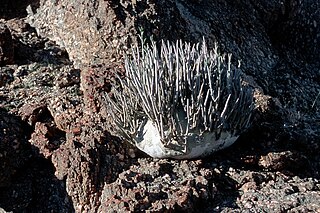
The Anacardiaceae, commonly known as the cashew family or sumac family, are a family of flowering plants, including about 83 genera with about 860 known species. Members of the Anacardiaceae bear fruits that are drupes and in some cases produce urushiol, an irritant. The Anacardiaceae include numerous genera, several of which are economically important, notably cashew, mango, Chinese lacquer tree, yellow mombin, Peruvian pepper, poison ivy, poison oak, sumac, smoke tree, marula and cuachalalate. The genus Pistacia is now included, but was previously placed in its own family, the Pistaciaceae.

The Crassulaceae, also known as the stonecrop family or the orpine family, are a diverse family of dicotyledon flowering plants characterized by succulent leaves and a unique form of photosynthesis, known as Crassulacean acid metabolism (CAM). Flowers generally have five floral parts. Crassulaceae are usually herbaceous but there are some subshrubs, and relatively few treelike or aquatic plants. Crassulaceae are a medium size monophyletic family in the core eudicots, among the order Saxifragales, whose diversity has made infrafamilial classification very difficult. The family includes approximately 1,400 species and 34–35 genera, depending on the circumscription of the genus Sedum, and distributed over three subfamilies. Members of the Crassulaceae are found worldwide, but mostly in the Northern Hemisphere and southern Africa, typically in dry and/or cold areas where water may be scarce, although a few are aquatic.

Aeonium, the tree houseleeks, is a genus of about 35 species of succulent, subtropical plants of the family Crassulaceae. Many species are popular in horticulture. The genus name comes from the ancient Greek αἰώνιος / aiōnios (ageless). While most of them are native to the Canary Islands, some are found in Madeira, Cape Verde, Morocco, in East Africa and Yemen.

Joseph Marie Henry Alfred Perrier de la Bâthie was a French botanist who specialized in the plants of Madagascar.

Adenia is a genus of flowering plants in the passionflower family Passifloraceae. It is distributed in the Old World tropics and subtropics. The centers of diversity are in Madagascar, eastern and western tropical Africa, and Southeast Asia. The genus name Adenia comes from "aden", reported as the Arabic name for the plant by Peter Forsskål, the author of the genus.

Operculicarya decaryi, known as elephant tree or jabily, is a thick stemmed succulent plant species in the family Anacardiaceae, named after the botanical collector Raymond Decary. It is found in Madagascar and is also grown as a bonsai tree.

Heinrich Gustav Adolf Engler was a German botanist. He is notable for his work on plant taxonomy and phytogeography, such as Die natürlichen Pflanzenfamilien, edited with Karl A. E. von Prantl.

Polyscias is a genus of flowering plants in the family Araliaceae. They bear pinnately compound leaves.

Rhodiola is a genus of perennial plants in the family Crassulaceae that resemble Sedum and other members of the family. Like sedums, Rhodiola species are often called stonecrops. Some authors merge Rhodiola into Sedum.

Poupartia is a genus of plant in family Anacardiaceae. From the islands of Madagascar, Mauritius, Rodrigues and Réunion, all in the Indian Ocean.

Rosularia is a small genus of the family Crassulaceae. It includes about 28-35 species from Europe, the Himalayas, and northern Africa.
Ischnolepis is a species of plants in the family Apocynaceae first described as a genus in 1909.

Schizolaena is a genus of trees and shrubs in the family Sarcolaenaceae. They are endemic to Madagascar.
Perrierodendron is a genus of trees and shrubs in the family Sarcolaenaceae. They are endemic to Madagascar.

Deeringia is a genus of flowering plants in the amaranth family Amaranthaceae. Its native range is tropical Asia, western Pacific, Australia and Madagascar.

Kalanchoe × poincarei is a species of Kalanchoe native to southern Madagascar. Its scientific name is often misapplied to K. suarezensis and K. mortagei, but K. × poincarei is very different from them. The true K. × poincarei is a natural hybrid involving K. beauverdii, with similar sprawling stems up to 3 m in length, and not known in cultivation, whereas K. suarezensis and K. mortagei are erect, 30~60 cm tall and cultivated as ornamentals.
Ivodea is a genus of flowering plants belonging to the family Rutaceae.
Micronychia is a genus of flowering plants in the family Anacardiaceae, with all species endemic to Madagascar, usually on the eastern side of the island.














